- <p align="center">
- <img height="140" src="https://cap.dotnetcore.xyz/img/logo.svg">
- </p>
-
- # CAP [中文](https://github.com/dotnetcore/CAP/blob/master/README.zh-cn.md)
- [](https://travis-ci.org/dotnetcore/CAP)
- [](https://ci.appveyor.com/project/yang-xiaodong/cap/branch/master)
- [](https://www.nuget.org/packages/DotNetCore.CAP/)
- [](https://www.nuget.org/packages/DotNetCore.CAP/)
- [](https://github.com/dotnetcore)
- [](https://raw.githubusercontent.com/dotnetcore/CAP/master/LICENSE.txt)
-
- CAP is a library based on .Net standard, which is a solution to deal with distributed transactions, has the function of EventBus, it is lightweight, easy to use, and efficient.
-
- In the process of building an SOA or MicroService system, we usually need to use the event to integrate each service. In the process, simple use of message queue does not guarantee reliability. CAP adopts local message table program integrated with the current database to solve exceptions that may occur in the process of the distributed system calling each other. It can ensure that the event messages are not lost in any case.
-
- You can also use CAP as an EventBus. CAP provides a simpler way to implement event publishing and subscriptions. You do not need to inherit or implement any interface during subscription and sending process.
-
- ## Architecture overview
-
- 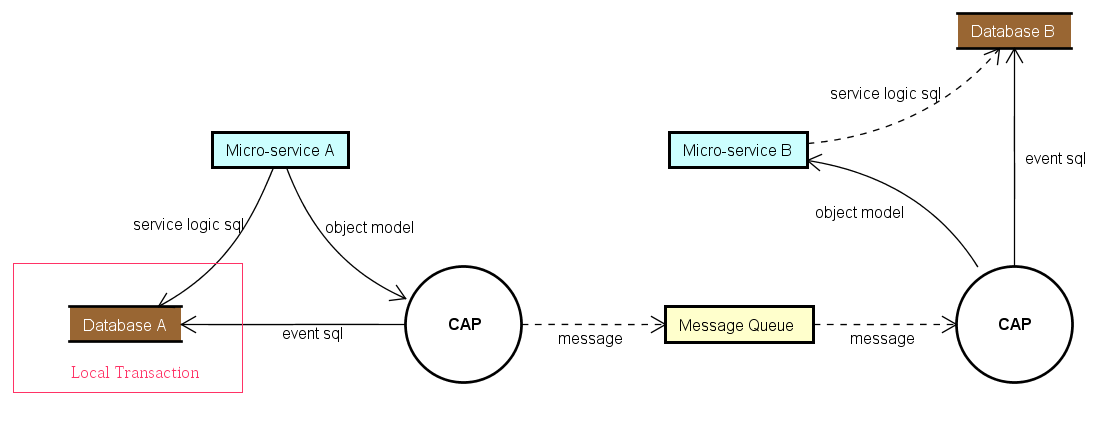
-
- > CAP implements the Outbox Pattern described in the [eShop ebook](https://docs.microsoft.com/en-us/dotnet/standard/microservices-architecture/multi-container-microservice-net-applications/subscribe-events#designing-atomicity-and-resiliency-when-publishing-to-the-event-bus).
-
- ## Getting Started
-
- ### NuGet
-
- CAP can be installed in your project with the following command.
-
- ```
- PM> Install-Package DotNetCore.CAP
- ```
-
- CAP supports RabbitMQ, Kafka and AzureService as message queue, following packages are available to install:
-
- ```
- PM> Install-Package DotNetCore.CAP.Kafka
- PM> Install-Package DotNetCore.CAP.RabbitMQ
- PM> Install-Package DotNetCore.CAP.AzureServiceBus
- ```
-
- CAP supports SqlServer, MySql, PostgreSql,MongoDB as event log storage.
-
- ```
- // select a database provider you are using, event log table will integrate into.
-
- PM> Install-Package DotNetCore.CAP.SqlServer
- PM> Install-Package DotNetCore.CAP.MySql
- PM> Install-Package DotNetCore.CAP.PostgreSql
- PM> Install-Package DotNetCore.CAP.MongoDB //need MongoDB 4.0+ cluster
- ```
-
- ### Configuration
-
- First, you need to configure CAP in your Startup.cs:
-
- ```cs
- public void ConfigureServices(IServiceCollection services)
- {
- //......
-
- services.AddDbContext<AppDbContext>(); //Options, If you are using EF as the ORM
- services.AddSingleton<IMongoClient>(new MongoClient("")); //Options, If you are using MongoDB
-
- services.AddCap(x =>
- {
- // If you are using EF, you need to add the configuration:
- x.UseEntityFramework<AppDbContext>(); //Options, Notice: You don't need to config x.UseSqlServer(""") again! CAP can autodiscovery.
-
- // If you are using ADO.NET, choose to add configuration you needed:
- x.UseSqlServer("Your ConnectionStrings");
- x.UseMySql("Your ConnectionStrings");
- x.UsePostgreSql("Your ConnectionStrings");
-
- // If you are using MongoDB, you need to add the configuration:
- x.UseMongoDB("Your ConnectionStrings"); //MongoDB 4.0+ cluster
-
- // CAP support RabbitMQ,Kafka,AzureService as the MQ, choose to add configuration you needed:
- x.UseRabbitMQ("ConnectionString");
- x.UseKafka("ConnectionString");
- x.UseAzureServiceBus("ConnectionString");
- });
- }
-
- ```
-
- ### Publish
-
- Inject `ICapPublisher` in your Controller, then use the `ICapPublisher` to send messages
-
- ```c#
- public class PublishController : Controller
- {
- private readonly ICapPublisher _capBus;
-
- public PublishController(ICapPublisher capPublisher)
- {
- _capBus = capPublisher;
- }
-
- [Route("~/adonet/transaction")]
- public IActionResult AdonetWithTransaction()
- {
- using (var connection = new MySqlConnection(ConnectionString))
- {
- using (var transaction = connection.BeginTransaction(_capBus, autoCommit: true))
- {
- //your business logic code
-
- _capBus.Publish("xxx.services.show.time", DateTime.Now);
- }
- }
-
- return Ok();
- }
-
- [Route("~/ef/transaction")]
- public IActionResult EntityFrameworkWithTransaction([FromServices]AppDbContext dbContext)
- {
- using (var trans = dbContext.Database.BeginTransaction(_capBus, autoCommit: true))
- {
- //your business logic code
-
- _capBus.Publish("xxx.services.show.time", DateTime.Now);
- }
-
- return Ok();
- }
- }
-
- ```
-
- ### Subscribe
-
- **In Controller Action**
-
- Add the Attribute `[CapSubscribe()]` on Action to subscribe to messages:
-
- ```c#
- public class PublishController : Controller
- {
- [CapSubscribe("xxx.services.show.time")]
- public void CheckReceivedMessage(DateTime datetime)
- {
- Console.WriteLine(datetime);
- }
- }
-
- ```
-
- **In Business Logic Service**
-
- If your subscription method is not in the Controller, then your subscribe class needs to implement `ICapSubscribe` interface:
-
- ```c#
-
- namespace BusinessCode.Service
- {
- public interface ISubscriberService
- {
- public void CheckReceivedMessage(DateTime datetime);
- }
-
- public class SubscriberService: ISubscriberService, ICapSubscribe
- {
- [CapSubscribe("xxx.services.show.time")]
- public void CheckReceivedMessage(DateTime datetime)
- {
- }
- }
- }
-
- ```
-
- Then register your class that implements `ISubscriberService` in Startup.cs
-
- ```c#
- public void ConfigureServices(IServiceCollection services)
- {
- //Note: The injection of services needs before of `services.AddCap()`
- services.AddTransient<ISubscriberService,SubscriberService>();
-
- services.AddCap(x=>
- {
- //...
- });
- }
- ```
-
- #### Subscribe Group
-
- The concept of a subscription group is similar to that of a consumer group in Kafka. it is the same as the broadcast mode in the message queue, which is used to process the same message between multiple different microservice instances.
-
- When CAP startups, it will use the current assembly name as the default group name, if multiple same group subscribers subscribe to the same topic name, there is only one subscriber that can receive the message.
- Conversely, if subscribers are in different groups, they will all receive messages.
-
- In the same application, you can specify `Group` property to keep subscriptions in different subscribe groups:
-
- ```C#
-
- [CapSubscribe("xxx.services.show.time", Group = "group1" )]
- public void ShowTime1(DateTime datetime)
- {
- }
-
- [CapSubscribe("xxx.services.show.time", Group = "group2")]
- public void ShowTime2(DateTime datetime)
- {
- }
-
- ```
- `ShowTime1` and `ShowTime2` will be called at the same time.
-
- BTW, You can specify the default group name in the configuration:
-
- ```C#
- services.AddCap(x =>
- {
- x.DefaultGroup = "default-group-name";
- });
-
- ```
-
- ### Dashboard
-
- CAP v2.1+ provides dashboard pages, you can easily view messages that were sent and received. In addition, you can also view the message status in real time in the dashboard. Use the following command to install the Dashboard in your project.
-
- ```
- PM> Install-Package DotNetCore.CAP.Dashboard
- ```
-
- In the distributed environment, the dashboard built-in integrates [Consul](http://consul.io) as a node discovery, while the realization of the gateway agent function, you can also easily view the node or other node data, It's like you are visiting local resources.
-
- ```c#
- services.AddCap(x =>
- {
- //...
-
- // Register Dashboard
- x.UseDashboard();
-
- // Register to Consul
- x.UseDiscovery(d =>
- {
- d.DiscoveryServerHostName = "localhost";
- d.DiscoveryServerPort = 8500;
- d.CurrentNodeHostName = "localhost";
- d.CurrentNodePort = 5800;
- d.NodeId = 1;
- d.NodeName = "CAP No.1 Node";
- });
- });
- ```
-
- The default dashboard address is :[http://localhost:xxx/cap](http://localhost:xxx/cap), you can configure relative path `/cap` with `x.UseDashboard(opt =>{ opt.MatchPath="/mycap"; })`.
-
- 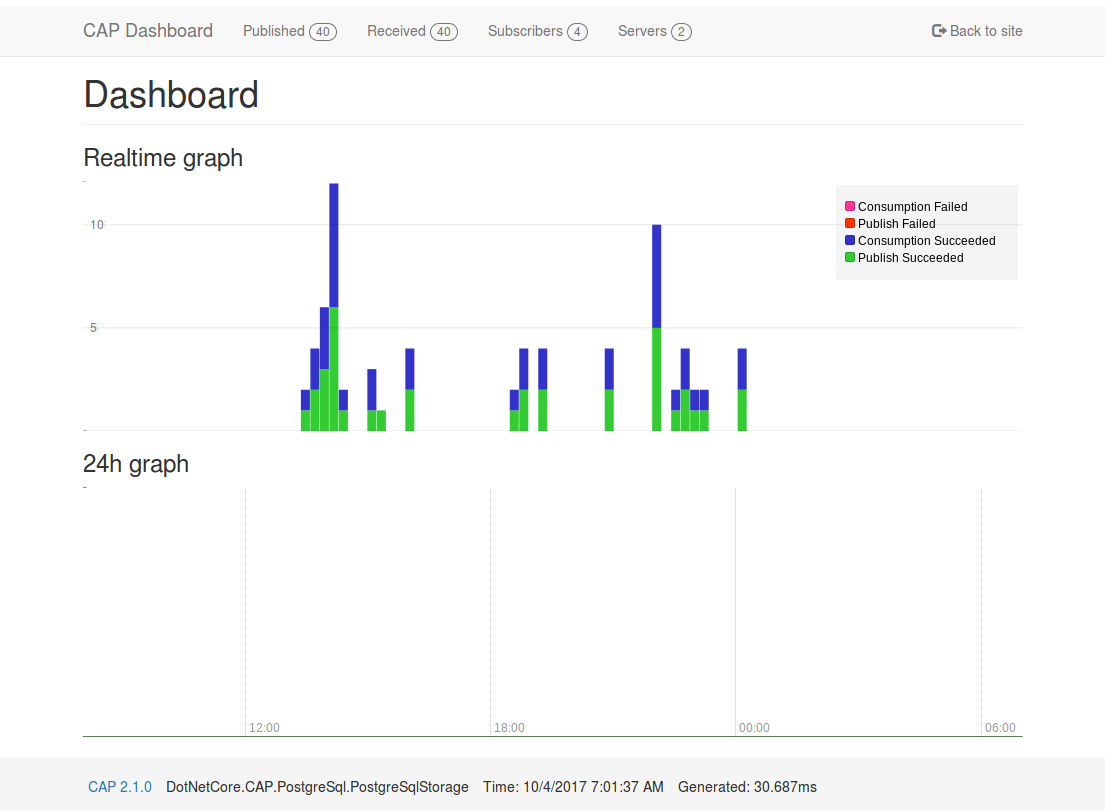
-
- 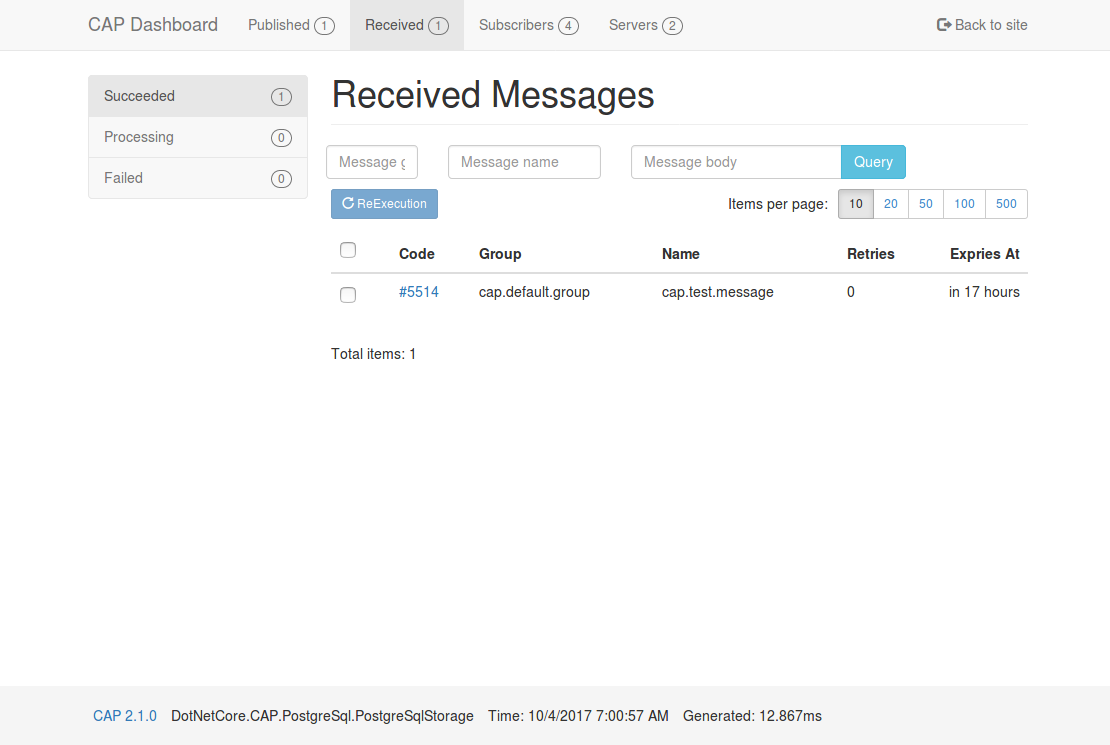
-
- 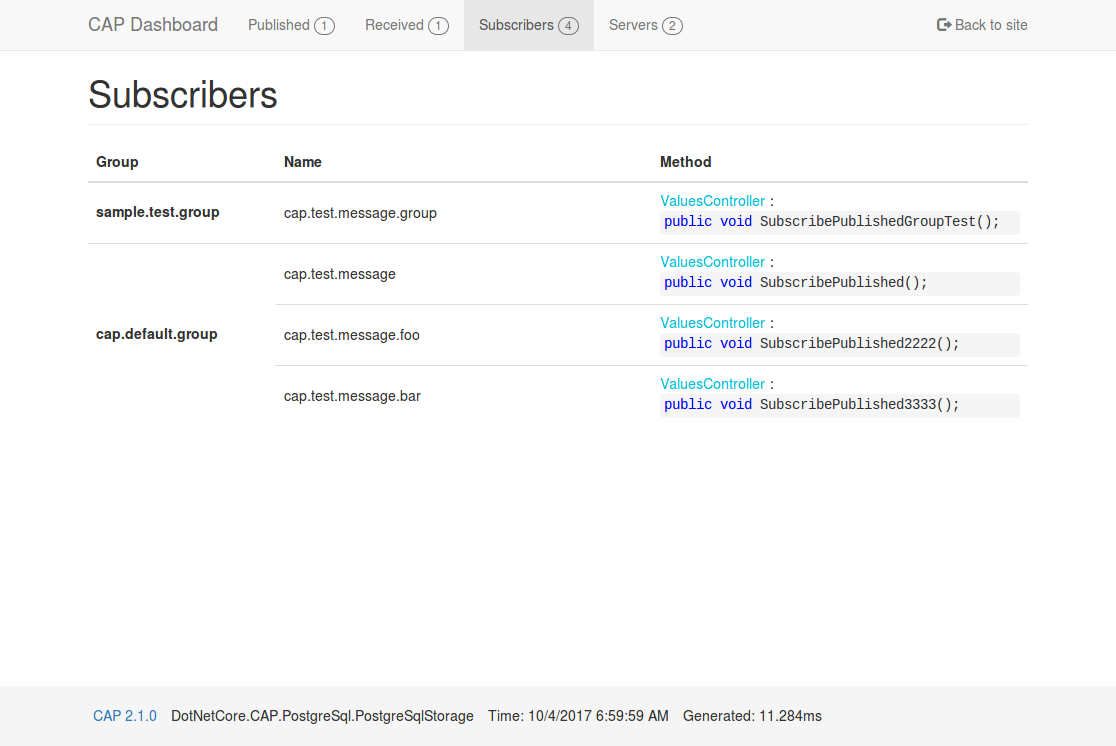
-
- 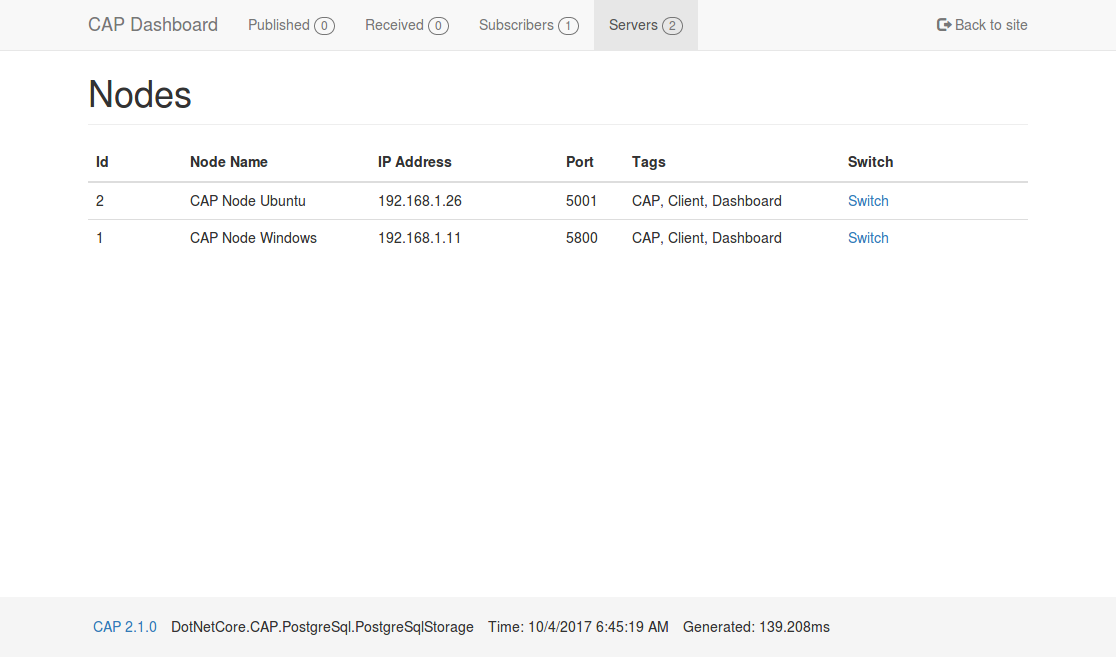
-
-
- ## Contribute
-
- One of the easiest ways to contribute is to participate in discussions and discuss issues. You can also contribute by submitting pull requests with code changes.
-
- ### License
-
- [MIT](https://github.com/dotnetcore/CAP/blob/master/LICENSE.txt)
|
